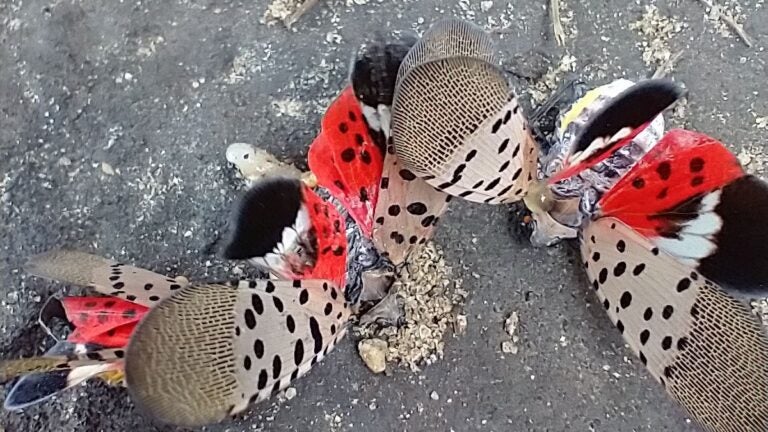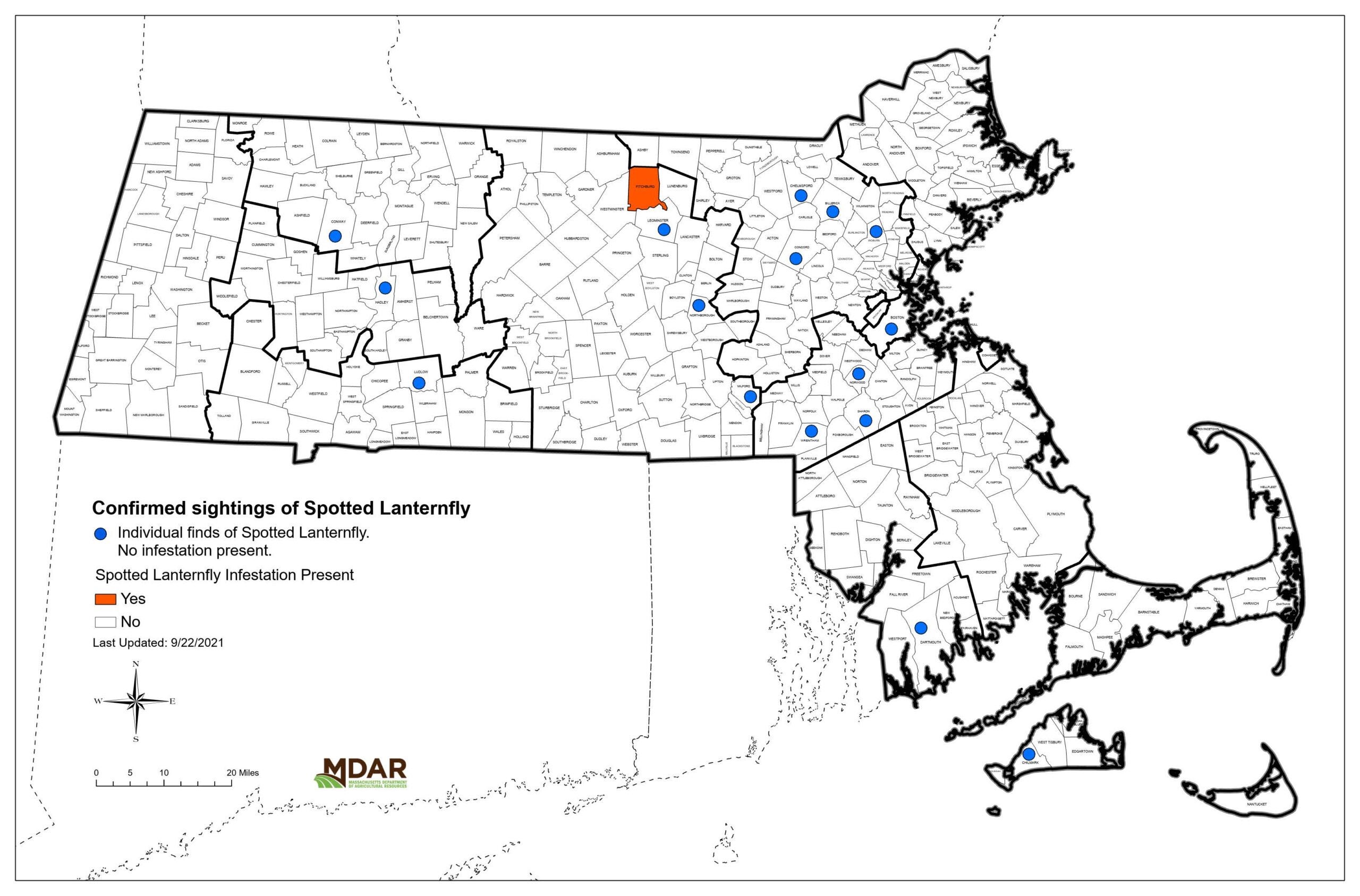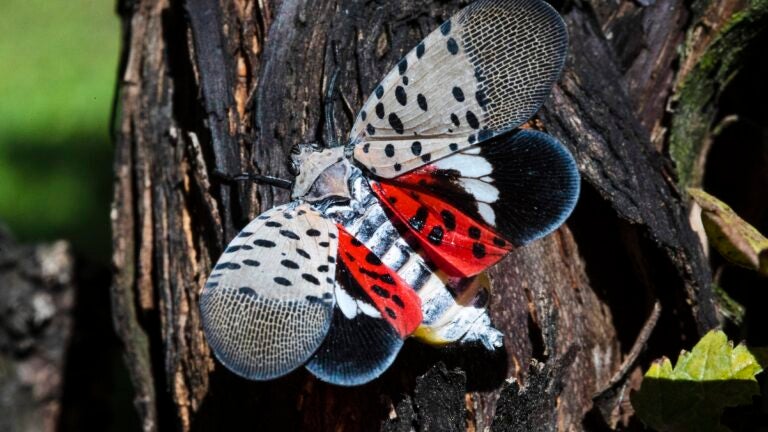"Spotted lanternfly is a threat to many agricultural crops that are important here in Massachusetts."

Have you seen this bug?
The spotted lanternfly may present a striking visage, but it’s an invasive pest that state officials are working to contain before it harms local trees and crops.
Though an adult spotted lanternfly is sometimes seen here and there around Massachusetts this time of year — usually brought here on a shipment or a traveler — there was never evidence the non-native species was breeding here until last week. On Sept 28, the Massachusetts Department of Agricultural Resources announced that an infestation of spotted lanternflies was found in a cluster of three trees in Fitchburg. The department is working quickly to survey and contain the infestation, but are warning people about the consequences of widespread spotted lanternfly breeding, and urging residents to report sightings.
State environmental biologist Jennifer Forman Orth emphasized that Massachusetts does not have a serious widespread infestation: the Fitchburg case is being thoroughly investigated, and other than that there have only been individual sightings of the insect around Massachusetts. She told Boston.com about why it’s so important to limit any spread of spotted lanternflies in Massachusetts.
“Spotted lanternfly is a threat to many agricultural crops that are important here in Massachusetts,” she said. “As we’ve seen in other states where spotted lanternfly has become established, it’s a huge nuisance pest and really can make it challenging for the public to enjoy the outdoors.”
A little about the spotted lanternfly, and why its presence is concerning
The spotted lanternfly is native to Asia, and was first found in the United States in Pennsylvania in 2014. Since then, infestations have been found in many states, including New Jersey, New York, and Connecticut. The first one spotted in Massachusetts, in 2018, was already dead, according to the Massachusetts Introduced Pests Outreach Project. In 2020, multiple dead and alive spotted lanternflies were found around the state, unintentionally shipped here on nursery stock, but no active infestation was found.

Spotted lanternflies can cause extensive, lasting damage to trees and crops, including apple trees, grape vines, hop vines, maple trees, lilacs, and willow trees. According to the MDAR, the insects attack trees by feeding on the sap and then secreting a residue called “honeydew,” which can cause sooty mold and attract other insects that can damage the plant.
When a tree is badly infested, Forman Orth said, it can look like the tree is raining, but it’s actually just the honeydew.
“In Pennsylvania…they’ve observed lanternflies causing significant damage to grapevines, so we’re very concerned about the impact that could have on local growers,” she said. “They’re still doing research on what the impact could be to trees…You’re not going to see an immediate impact on trees…you see over time that trees become less viable, they have other health issues…they become less competitive when it comes to invasive species issues, we could see invasive plants coming into forests because the native trees are getting attacked.”
Recognizing and reporting the spotted lanternfly
Spotted lanternflies are pretty distinct when their red under-wings are showing, but can effectively blend into tree bark when their wings are folded up.

Spotted lanternfly egg masses are commonly mistaken for lichen on a tree, and look similar to a dried smear of mud.

It’s not necessarily a good idea to squish on sight, though, which is why state officials want people to report sightings with photos and locations. There are several native species that closely resemble spotted lanternflies, and Forman Orth doesn’t want increased awareness of the spotted lanternfly to endanger the other, harmless insects. Virginia Tech put together a helpful guide on common lookalikes, and MDAR put together a form to teach people how to “spot the lanternfly.”
As with the adult lanternflies, Forman Orth recommends taking a photo and reporting the eggs. Experts can identify the insect and eggs within a minute, and since eggs won’t hatch until spring, there is plenty of time to check them out.
“If the infestation was a lot more extensive we’d be having a different conversation, to the point where people could easily recognize lanternfly because they’re seeing them all the time…but that’s really not happening right now,” she said. “If someone can send a photo we can ID it – maybe we can’t tell exactly what it is but we can tell if it’s a lanternfly.”
Newsletter Signup
Stay up to date on all the latest news from Boston.com
"need" - Google News
October 05, 2021 at 07:57AM
https://ift.tt/3mnMlD6
The spotted lanternfly has arrived. Here’s everything you need to know. - Boston.com
"need" - Google News
https://ift.tt/3c23wne
https://ift.tt/2YsHiXz
Bagikan Berita Ini
















0 Response to "The spotted lanternfly has arrived. Here’s everything you need to know. - Boston.com"
Post a Comment